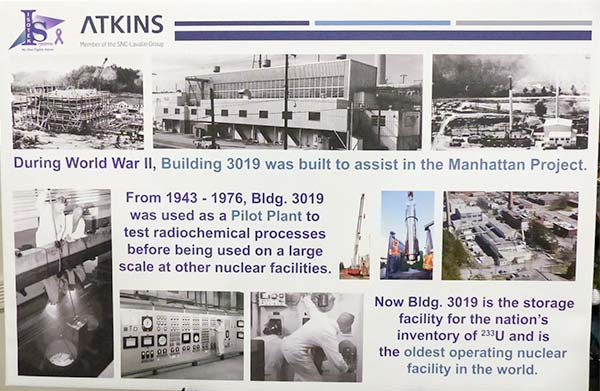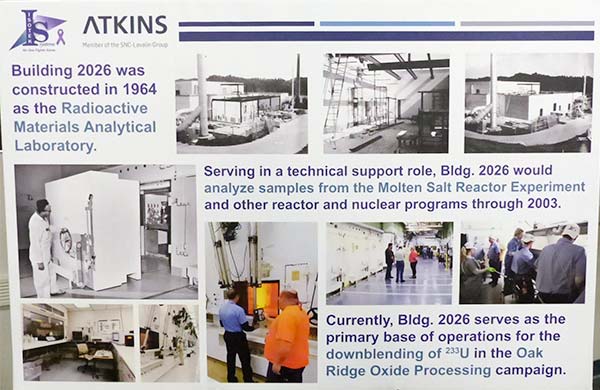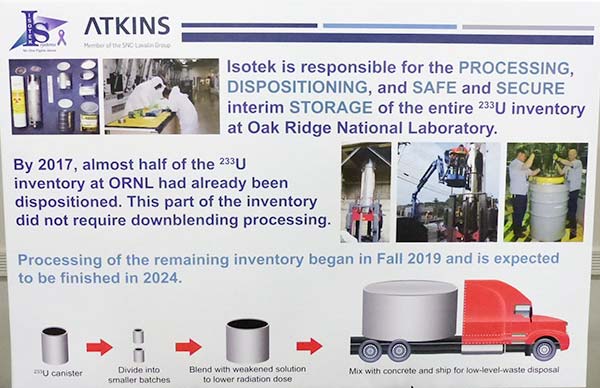
The U.S. Department of Energy plans to demolish the oldest operating nuclear facility in the world.
The cleanup and demolition of Building 3019 at Oak Ridge National Laboratory could start sometime around 2030.
But the work won’t start until more than 500 canisters of uranium-233 stored in the building have been processed and removed, possibly by 2025.
More than 70 years old, Building 3019 was built during World War II as part of the top-secret Manhattan Project. That was a top-secret federal program to build the world’s first atomic bombs.
From 1943-1976, the building was used as a pilot plant to test radiochemical processes before they were used on a large scale at other nuclear facilities.
Now Building 3019 stores the nation’s inventory of uranium-233. Processing and removing that uranium is the top cleanup priority at ORNL because, among other things, storing the highly enriched fissile nuclear material increases security costs and creates nuclear safety issues. The cleanup work is being done by DOE’s Oak Ridge Office of Environmental Management and its contractor Isotek.
The uranium that is left in Building 3019 is stored in different forms, including oxide powders, metal, monoliths, and sodium fluoride traps from ORNL’s Molten Salt Reactor Experiment. It is being processed in Building 2026 at ORNL, across the street from Building 3019. The processing of low-dose uranium oxide powders started in glove boxes in Building 2026 in October, Isotek President Jim Bolon told the Oak Ridge Site Specific Advisory Board in February.
Stored in canisters, the waste is being divided into smaller batches, blended with a weakened solution to lower the radiation dose, and mixed with concrete and shipped as low-level waste to a disposal site designated by DOE.
While some of the waste is being processed in glove boxes, most of the remaining canisters stored at ORNL are more radioactive, and they will have to be processed in hot cells in Building 2026, possibly starting near the end of the year, Bolon said. The uranium processing work could take about five years, he said.
The project has been boosted by an agreement with TerraPower, a company co-founded by Microsoft’s Bill Gates. Isotek is removing thorium-229 from the uranium-233 as it processes the material for disposal and selling the thorium to TerraPower. TerraPower will then extract actinium-225 from the thorium for use in cancer treatment research.
Although the purchase price is confidential, Isotek will use the money from the sale of the thorium-229 to pay for part of the uranium-233 disposal. That allows the uranium processing operations to begin a year ahead of schedule and saves about $90 million through direct private funding and reduced costs as the material is removed from storage, according to DOE.
Besides the building demolition, the cleanup of Building 3019 could include soil remediation. On Monday, the DOE Oak Ridge Office of Environmental Management said it will understand the need for any soil remediation after the structure is demolished and workers have had the chance to characterize and survey the area.
The uranium stored at ORNL came to the lab from DOE-related missions at sites across the country. About half of the more than 1,000 canisters of the material that had been stored at the lab have been transferred and disposed of, mostly at the Nevada National Security Site northwest of Las Vegas. That waste did not require processing, Bolon said.
Isotek has been responsible for overseeing the uranium-233 inventory at ORNL and preparing for its removal since 2003. The company’s uranium disposition contract, which has been valued at $557 million and in effect through December 2024, is managed by DOE’s Oak Ridge Office of Environmental Management.
Uranium-233 is a radioactive isotope of uranium that does not exist in nature, but it can be produced by bombarding thorium-232 with neutrons. Although it was created as an additional fuel source for nuclear reactors, uranium-233 has proved to be unviable as a fuel source because its creation also generated uranium-232, a highly unstable radioactive isotope, according to DOE and its contractors.
Although it is used for “down blending” uranium-233 now, Building 2026 at ORNL was built in 1964 as the Radioactive Materials Analytical Laboratory. It served in a technical support role, analyzing samples from the Molten Salt Reactor Experiment and other reactor and nuclear programs through 2003.



Leave a Reply